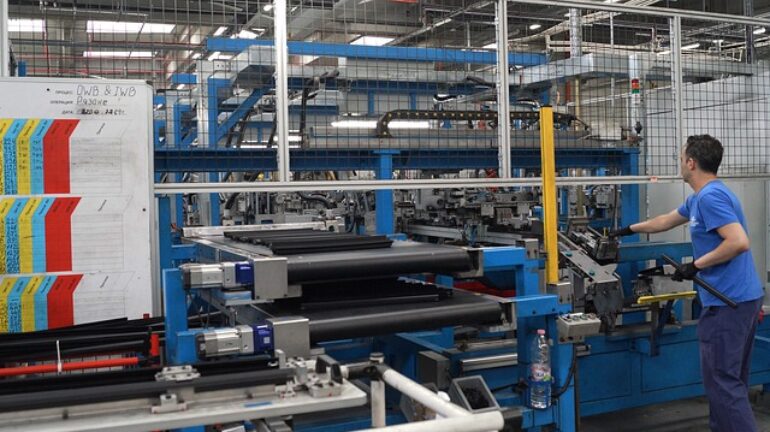
The Indian component manufacturing industry is a powerhouse, contributing significantly to the nation’s economic growth. But in a competitive global market, staying ahead requires constant optimization. This is where Overall Equipment Effectiveness (OEE) comes in as a powerful metric that empowers manufacturers to identify areas for improvement and achieve peak production efficiency.
What is OEE?
OEE is a holistic approach to measuring manufacturing performance. It takes into account three key factors:
- Availability: The percentage of time a machine is operational and ready to produce.
- Performance: The rate at which the machine produces good quality components compared to its ideal speed.
- Quality: The percentage of produced components that meet the required specifications.
By multiplying these three factors (Availability x Performance x Quality), manufacturers get a clear picture of their OEE score. Typically, a score above 85% indicates world-class efficiency.
Why is OEE crucial for Indian component manufacturers?
-
Reduced Costs: Higher OEE translates to less downtime, minimized scrap, and optimized resource utilization, leading to significant cost savings.
-
Enhanced Quality: OEE promotes a focus on quality throughout the production process, ensuring components consistently meet specifications.
-
Data-Driven Decisions: OEE data provides valuable insights to identify bottlenecks, prioritize maintenance activities, and make informed decisions for continuous improvement.
-
Improved Competitiveness: By streamlining production and minimizing waste, manufacturers can deliver high-quality components faster and at competitive prices.
OEE in Action:Use Cases for Component Manufacturers
Optimizing Machine Availability: OEE analysis can pinpoint recurring downtime reasons, allowing manufacturers to implement preventive maintenance strategies and improve machine uptime.
Minimizing Setup Times: Analyzing OEE data can help identify areas for improvement in changeovers between production runs, leading to faster setup times and increased production capacity.
Reducing Process Defects: By monitoring OEE and identifying quality issues early on, manufacturers can take corrective actions and minimize production of defective components.
Benchmarking Performance: OEE allows manufacturers to compare their performance against industry standards and identify areas where they can improve efficiency.
Taking the Next Step with OEE
Implementing OEE requires a commitment from leadership and a culture of continuous improvement. Here’s how Indian component manufacturers can get started:
Invest in Data Collection Systems: Integrate data collection tools with machines to track production parameters and calculate OEE.
Train Employees: Foster a culture of data-driven decision making by training employees on OEE principles and how to interpret the data.
Set Realistic Goals: Start with achievable OEE improvement targets and gradually raise the bar as your processes become more efficient.
Continuous Improvement:Regularly analyze OEE data, identify areas for improvement, and implement corrective actions to achieve sustained efficiency gains.
By embracing OEE, Indian component manufacturers can unlock significant competitive advantages. With a focus on data-driven decision making and continuous improvement, they can optimize production processes, reduce costs, and deliver high-quality components to meet the demands of the global market.
Frequently Asked Questions (FAQs)
1. What exactly is an IIoT-backed OEE solution?
An IIoT-backed OEE solution connects machines and sensors to a central system. It automatically collects performance data. This eliminates manual data entry. It provides real-time, accurate insights into your production.
2. How does IIoT data make my OEE score more accurate?
Traditional OEE relies on manual logging. This can be prone to human error. IIoT sensors directly capture machine run times, downtime events, and part counts. This gives you a precise and objective OEE score.
3. What are the key benefits of this technology?
The benefits are numerous. You get a live dashboard of your plant’s performance. You can also identify hidden bottlenecks instantly. This allows for predictive maintenance. You can fix problems before they cause major downtime.
4. Is this technology difficult or expensive to implement?
Initial setup requires some investment. However, the return is often significant. Modern solutions are designed to be scalable. They can be integrated with existing machines. This often makes implementation smoother.
5. Can IIoT help me predict maintenance needs?
Yes, absolutely. IIoT sensors monitor equipment health. They can detect subtle changes in vibrations or temperature. This data is analyzed to predict potential failures. You can then perform maintenance proactively.
Your Turn to Innovate!
The blend of IIoT and OEE is a game-changer. It takes your production from reactive to proactive. It provides the data you need to drive real change. This is the future of manufacturing.
What is the biggest technology challenge you’re currently facing in your plant? Have you considered using IIoT solutions to boost your OEE? Share your thoughts and questions in the comments below.
#IIoT, #OEE, #SmartManufacturing, #Industry40, #FactoryAutomation, #DigitalTransformation, #Productivity, #IoT, #DataAnalytics, #ManufacturingTech

